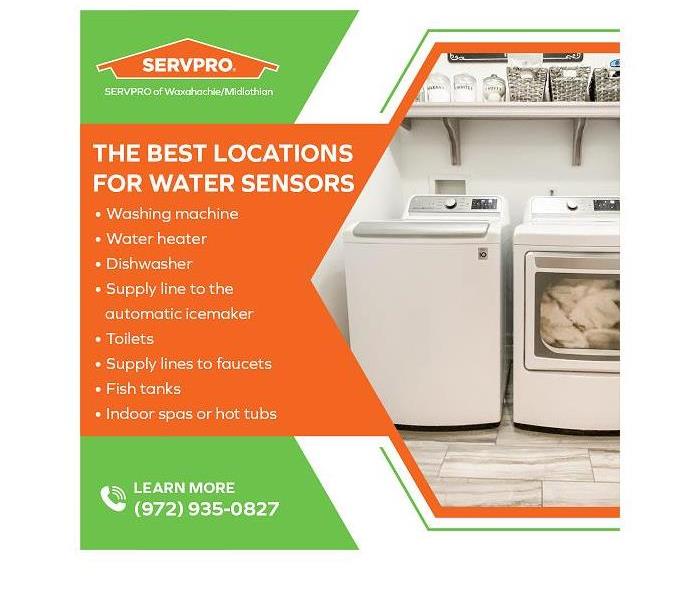Water Sensors: A Prevention Strategy to Avoid Extensive Water Damage in the Home
6/9/2022 (Permalink)
Blog Summary: SERVPRO of Waxahachie / Midlothian explains how integrating water sensors into a home water damage prevention strategy can help avoid a major water damage disaster.
The certified property damage restoration professionals at SERVPRO of Waxahachie / Midlothian highlight the benefits of integrating water sensors into a water damage prevention strategy for the home. As is the case with most risk hazards such as water damage, prevention of a property damage disaster is far less costly in terms of time, money, and inconvenience than an actual fire, smoke, flood, or water damage disaster.
If an intervention does not occur quickly after a pipe breaks or a supply line ruptures, the flooding can cause extensive damage to a home. If the homeowner is away on vacation or on an extended business trip, the leak may go undetected for days or even weeks. Each day, nearly ten thousand gallons of water will flow out of the burst water line. The consequences are potentially catastrophic.
After 24-48 hours, mold begins to grow on the walls, cabinets, and upholstery. Water-soaked personal belongings become unsalvageable after only a short time. Advanced secondary damage includes warped flooring, swollen baseboards, contaminated carpet, blistered paint and finishing on wood products, and ruined electronics. Water and moisture negatively impact every surface in the home. Modern, affordable technology can prevent this water damage disaster scenario from becoming a sad, traumatic reality.
By instantly alerting the homeowner to a water leak, the smart technology in water-sensor systems can avert a potential major water damage disaster, avoiding the need for expensive, disruptive, and time-consuming property damage cleanup and restoration.
Water damage is a frequent and expensive cause of loss in the home. Forty percent of homes suffer some form of water damage. Property management analysts offer the following water damage statistics: “The average home insurance claim for water damage is $11,098. Ninety-eight percent of basements experience some sort of water damage. 14.6 million U.S. homes are at risk of flooding….Nationwide, household water damage costs up to $20 billion annually.”
Cutting-edge smart home technology assists the consumer in managing personal risks. Water sensors serve to mitigate water damage. By doing so, this amazing technology empowers the homeowner to avoid suffering the loss of personal belongings. When water sensor technology works, homeowners are freed from the inconvenience and headache of managing the cleanup, restoration, and repairs needed to recover from a water damage disaster.
Water Sensors and How They Work
As the name implies, a water sensor detects the presence of water or moisture. When Wi-Fi is enabled, the sensor can send a notification to the homeowner’s smartphone warning that a water release is in progress. Alternate recipients can be designed to receive and act upon the text message if the homeowners are unavailable to respond or are out of town.
More sophisticated water-sensor systems are capable of being programmed to turn off the water to the house. This auto-shutoff feature provides a shield against a major water damage disaster where the sensors are in place. Consult with a qualified plumbing professional before installing the sensor-activated water shut-off devices.
The Best Locations for Water Sensors
Place sensors in areas near appliances or devices that have water connections, such as:
- Washing machine
- Water heater
- Dishwasher
- Supply line to the automatic ice maker
- Toilets
- Supply lines to faucets
- Fish tanks
- Indoor spas or hot tubs
Regular inspections and scheduled maintenance of connections, valves, and supply lines are effective preventive measures to avoid a water damage disaster in the home.
More Helpful Tips about Water Sensors
Tip #1: Product options and availability are extensive.
Most big box home improvement stores carry a variety of water sensors and their control modules. The online marketplace for water sensor technology offers a variety of choices and can be confusing for the typical DIY homeowner.
Tip #2: Research options before making a purchase.
Define the needs and determine budget limitations. Identify the options that meet the specific needs within the prescribed budget.
Tip #3: Options are varied.
Not all water sensors are equal. The simplest and most economical devices work only once and then must be replaced. More expensive units are engineered to provide multiple alerts and extended use.
Tip #4: Consult with a professional for product selection, placement, and installation.
DIY-savvy homeowners may want to select, place, and install water leak sensors by themselves. However, the homeowner or property manager who is not comfortable installing the water sensor devices should hire an experienced, licensed professional to install the sensors and set up the notification app if the system uses Wi-Fi.
When homeowners need water damage cleanup in the aftermath of a property damage disaster, the professionals at SERVPRO of Waxahachie/Midlothian are ready to spring into action. They have served the area for over twenty years, providing round-the-clock service 365 days a year, including holidays. Because the SERVPRO franchise is centrally located in Ellis County, the team can respond quickly, usually within an hour or less. The restoration experts specialize in residential, commercial, and large-scale disaster cleanup and restoration.
For more information about SERVPRO of Waxahachie/Midlothian’s water damage restoration services in Red Oak, TX and surrounding areas, contact the office at (972) 935-0827 or email acarey@SERVPRO10932.com



 24/7 Emergency Service
24/7 Emergency Service
